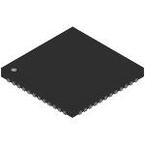Product Details
●The AD9545 supports existing and emerging ITU standards for the delivery of frequency, phase, and time of day over service provider packet networks.
●The 10 clock outputs of the AD9545 are synchronized to any one of up to four input references. The digital phase-locked loops (PLLs) reduce timing jitter associated with the external references. The digitally controlled loop and holdover circuitry continuously generate a low jitter output signal, even when all reference inputs fail.
●The AD9545 is available in a 48-lead LFCSP (7 mm × 7 mm) package and operates over the −40°C to +85°C temperature range.
●Applications
● GPS, PTP (IEEE-1588), and SyncE jitter cleanup and synchronization
● Optical transport networks (OTN), SDH, Carrier Ethernet, and macro and small cell base stations.
● OTN mapping/demapping with jitter cleaning
● Small base station clocking, including baseband and radio
● Stratum 2, Stratum 3e, and Stratum 3 holdover, jitter cleanup, and phase transient control
● JESD204B support for analog-to-digital converter (ADC) and digital-to-analog converter (DAC) clocking
● Cable infrastructures
● Carrier Ethernet
●### Features and Benefits
● Dual DPLL synchronizes 1 Hz to 500 MHz physical layer clocks providing frequency translation with jitter cleaning of noisy references
● Complies with ITU-T G.8262 and Telcordia GR-253
● Supports Telcordia GR-1244, ITU-T G.812, G.813, G.823, G.824, G.825, and G.8273.2
● Continuous frequency monitoring and reference validation for frequency deviation as low as 50 ppb
● Both DPLLs feature a 24-bit fractional divider with 24-bit programmable modulus
● Programmable digital loop filter bandwidth: 10-4 to 1850 Hz
● Two independent, programmable auxiliary NCOs (1 Hz to 65,535 Hz, resolution < 1.4 × 10−12 Hz), suitable for IEEE-1588 Version 2 servo feedback in PTP applications
● Automatic and manual holdover and reference switchover, providing zero delay, hitless, or phase buildout operation
● Programmable priority-based reference switching with manual, automatic revertive, and automatic nonrevertive modes supported
● 5 pairs of clock output pins with each pair useable as differential LVDS/HCSL/CML or as two single-ended outputs (1 Hz to 500 MHz)
● 2 differential or four single-ended input references
● Cross point mux interconnects reference inputs to PLLs
● Supports embedded (modulated) input/output clock signals
● Fast DPLL locking modes
● Supports a 25 MHz to 52 MHz crystal resonator, TCXO, or OCXO for system clock and provides for system clock frequency stability compensation
● External EEPROM support for autonomous initialization
● Single 1.8 V power supply operation with internal regulation
● Built-in temperature monitor/alarm and temperature compensation for enhanced zero delay performance


